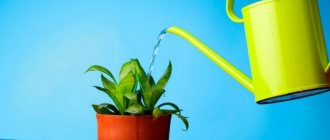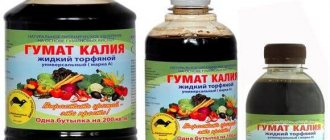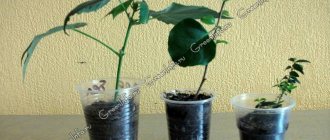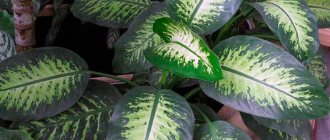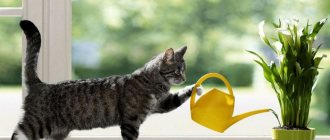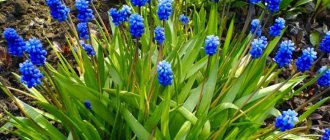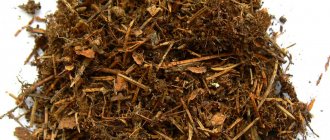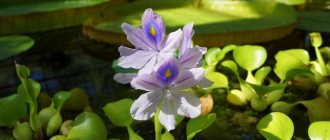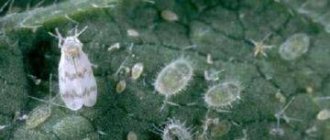The choice of soil mixture must be taken seriously. The soil mixture should have a dense structure to hold the plant in the pot and allow the roots to take root. Also, the soil mixture must retain the necessary moisture, because the roots of indoor plants receive nutrition during watering in the form of mineral fertilizers dissolved in water. But at the same time, excess moisture should not linger in the pot, the earthen mixture should remain breathable and not cake, the roots of the plant should breathe.
Beginning flower growers will sooner or later be faced with the question: which soil is better to choose - purchased soil or can you use simple garden soil?
Modern commercial nutrient mixtures for indoor plants can hardly be called earthen. We can say that there is no land as such there. The composition of purchased soil mixtures includes many materials that allow plants not only to take root, but also to feel great, but without knowing about their properties, we would never have guessed that such artificial materials are widely used in the production of soils. Such materials include expanded clay, vermiculite, asbestos, pozzolan, perlite and some other materials, including synthetic fiber.
Expanded clay
Expanded clay is a building material, but it is so necessary in indoor floriculture. Small brown porous balls of expanded clay, obtained from clay by firing, do not absorb water at all. Therefore, in indoor floriculture, expanded clay is successfully used as drainage. If expanded clay balls are broken into smaller pieces, it can be added to the substrate to prevent the soil in the pot from caking. Small particles of expanded clay contribute to better aeration of the soil in a flower pot.
Expanded clay can be used for aesthetic purposes on the surface of the substrate. Over time, a whitish coating forms on the top layer of soil in the pot. These are salt deposits from fertilizers, lime deposits from irrigation with hard tap water. If you sprinkle a little expanded clay on the surface of the soil in a pot, it will mask both the substrate and deposits of mineral salts.
Using expanded clay you can maintain constant air humidity. To do this, you need to take a tray with expanded clay, pour water into it, and place pots with indoor plants that need constant high humidity on the tray.
How to make acidic soil at home
There are several ways to increase soil acidity at home. The choice depends on the mechanical composition of the soil. Light and loose mixtures can be acidified by adding a significant portion of organic matter. For example, compost, sphagnum moss or regular mullein. The disadvantage of this method is the presence of a huge amount of organic matter to obtain significant changes in pH.
For heavy and dense soils, it is necessary to use other methods, since organic matter will further increase the alkali content. In this case, it is necessary to acidify the soil using any of the following methods:
- adding sulfur;
- adding ferrous sulfate;
- use of urea or other products containing ammonia.
Important! You can increase acidity with lemon or sorrel, or rather with the acid they contain. Before acidifying the soil with citric acid, it is necessary to dilute it in liquid in the correct proportion: add 15 g of acid to 1 liter of water.
By selecting all the ingredients for preparing the substrate at home, you can obtain the optimal soil for house plants. They, in turn, will reward you with good foliage development and abundant flowering.
Perlite
Another component of the soil mixture can act as a kind of soil fan - perlite. Perlite is elastic silica with a small mass. In purchased earthen mixtures it is found in the form of small and very light gray or white balls or granules. Perlite is becoming an indispensable component in soil mixtures. Due to the fact that it is very light, perlite is used instead of river sand in earthen mixtures.
By the way, perlite can be used as an independent component or in the form of a mixture with river sand or vermiculite for rooting cuttings or young plants, especially if these plants are afraid of stagnant moisture. And if you add a fifth of perlite to soil mixtures containing garden soil and low-lying peat, you will achieve excellent results. Perlite can be used as an inert material for growing plants hydroponically . Perlite can be purchased separately from the soil mixture at a flower shop.
Planting bulbs: preparing and improving the soil
Bulbous and tuberous plants prefer drained soil enriched with nutrients and do not like stagnant moisture. Determining what type of soil you have in your garden is quite simple. Dig a hole approximately 30 cm deep. Remove a handful of soil from the deepest place and check its structure. If the soil slips through your fingers and it is impossible to form a lump or sausage from it, then we are talking about light sandy soil. If dry soil crumbles when you try to compact it, then you have heavy clay soil. The easier it is to roll a sausage from damp soil, the higher the clay content in it. If the soil in the garden is far from ideal, it can be improved.
Pozzolan
Pozzolan is another silica of volcanic origin. Due to its hygroscopic quality (it can retain moisture), pozzolan has found its use in the production of soils. When added to substrates, pozzolan is crushed into small particles, thanks to which the substrate in the pot does not cake.
Large pozzolan is added to soil mixtures intended for flower pots or containers with a water reservoir. Also, large pozzolan can be used as drainage instead of expanded clay. Pozzolan granules create more intense air exchange in such containers, unlike expanded clay, to which the raw mixture sticks very quickly.
Besides drainage, pozzolan has another use. In order to always have moist air around the plants, they need to be placed in trays filled with pre-soaked pozzolan. Gradually drying out, the pozzolan will evaporate the moisture, and the plants will be able to enjoy the moisture without the risk of their roots rotting.
Asbestos fiber
Asbestos fiber is another building material that would seem to have nothing to do with floriculture. However, he also found a use. In itself, asbestos fiber is a fibrous material with a compacted structure, very close in its properties to glass and wool. Asbestos fiber can remain wet for a long time, but is not subject to rotting; it is these qualities that are taken into account in the production of soils. Asbestos fiber retains moisture well, and thanks to its density, the desired humidity of the substrate can be achieved. Asbestos fiber is found in substrates in the form of small cubes. If you like experiments, you can try to grow indoor plants only in asbestos fiber, adding various fertilizers to the substrate in small portions or drops.
Vermiculite
Another component of the earthen mixture is vermiculite . Vermiculite, like expanded clay, is made from clay, which is heated to a certain high temperature. In appearance it resembles cork or wood shavings. Vermiculite is an inert and very light material that does not interact with the plant itself, but only serves as a soil fan.
Vermiculite can be used instead of river sand in its pure form or mixed with perlite for rooting cuttings or germinating seeds in mini-greenhouses, since small plants take root well in a light and airy substrate. In ready-made earthen substrates, vermiculite maintains the substrate in an airy state, prevents soil caking and serves as an excellent means of drainage, since it does not retain water at all.
Always check the acidity
It is very important to check which soil reaction the plant prefers. Even if a specific permissible pH value is not indicated for a species, it is necessary to indicate whether it needs a neutral, slightly acidic or slightly alkaline substrate. In soil with an inappropriate reaction, not a single plant will be able to develop normally.
Most plant species prefer neutral or slightly acidic values - from 5.5 to 6.5 pH. The permissible deviation from this “average” for special soil mixtures is only 1 point (4.5-7.5 pH).
Dolomite
Dolomite is a quarried sedimentary rock composed of calcium carbonate, lime spar and manganese. Dolomite is crushed and added to substrates as dolomite flour to reduce the acidity of peat substrates, as well as to create a deliberately alkaline reaction of the soil mixture, based on the requirements of certain plants. For example, dolomite flour is an indispensable component in the substrate for Paphiopedilum, the only orchid that prefers non-acidic soil.
Charcoal
It has long been known that charcoal has antiseptic properties. It can be added to the vase where the bouquet stands, or to the water where the cuttings are placed for rooting. The presence of coal allows the water to remain clean and not rot. If the cuttings are rooting in a hard substrate, dip the cuttings in charcoal powder before planting them, this will also help prevent the cuttings from rotting. Charcoal can be ground to a powder and used in substrates intended for plants such as orchids or cacti, which have thick, delicate roots that are very sensitive to moisture and can rot quickly.
river sand
River sand is a necessary component of almost any earthen mixture. River sand is widely used in indoor floriculture for rooting cuttings or germinating seeds. In ready-made substrates intended for germinating seeds, rooting cuttings, as well as in substrates for cacti and succulents, the sand content can reach 30-40%. River sand does not retain water at all, so it can also be used as drainage. Sand does not contain any nutrients, but its presence prevents the soil from caking and provides soil ventilation.
River sand especially needs to be added to soils for large and tall indoor plants. Firstly, soils for large plants often cannot be changed, so there is a risk of soil caking. Secondly, if you add more sand to the tubs and pots, this will help maintain the balance of the pot, since the sand is heavy, and the center of gravity will always be in the pot.
For indoor floriculture, quartz river sand is used. Quarry sand contains many impurities, for example, loam, which has an alkaline reaction. As a rule, loams tend to cake, so it is better not to add such sand to flower pots.
Pure quartz sand can be found in aquarium supply stores. If you do not have this opportunity, then take any sand, rinse it thoroughly, and then calcine it. Only after this can it be added to earthen mixtures.
Ready-made soil (soil mixtures) for indoor plants
Up to this point, we have been talking all the time about what components are needed for the soil mixture, implying its own preparation. However, it is not always possible for an amateur gardener, especially an urban one, to burn charcoal, stock up on meadow turf and let the compost stand for two years. More often than not, you have to combine components that you have extracted yourself with those that you have purchased, and this is not a bad option at all!
But even this may not be possible for a busy person who simply does not have enough free time for all this. The same often applies to rural residents, who also cannot be blamed for idleness.
These problems have long been successfully solved by manufacturers of ready-made soil substrates and other useful little things like expanded clay or calibrated pebbles for drainage in a pot. It’s enough just to stop by the store on the way home and buy the right amount of soil (the packaging comes in a variety of sizes).
The choice today is large; for almost every individual plant there is a specially developed soil composition, but all of them can be classified according to one main characteristic - the base used, of which there are only two: soil and peat.
Peat based substrate
Peat substrate is very popular among gardeners all over the world because it is easy and convenient to handle, and it suits the vast majority of indoor plants.
The advantages include consistently high quality (undemanding in production), light weight, and no special skills required for planting plants at home. It is only important to compact the peat soil well in the volume of the pot to give greater stability to the flower or other plant that you are planting.
Peat soil also has disadvantages. More likely, not disadvantages, but features that need to be taken into account when caring for your home “botanical garden”. Such features are the weak stability of large plants in a pot, it dries out faster and is more difficult to saturate with moisture, and is even more likely to require fertilizing than the soil substrate.
Soil based substrate
The main advantages of the soil substrate can be considered qualities that are opposite to the disadvantages of peat soil, namely: large plants feel stable in a pot and a longer period of saturation of plants with nutrients before fertilizing is required.
Read also Growing and harvesting potatoes. Timing, methods, devices. Expert advice
In addition, it is the soil substrate that is distinguished by a huge range of specialized soils for specific types of indoor plants. Peat compositions are more universal.
As a rule, meadow turf is used as the basis for soil substrates in their production, which in the process is enriched with fertilizers and the most important elements for indoor plants - peat, bone meal, potassium sulfate, superphosphate, and sand is also added to give the soil the required conditions.
Peat
High-moor peat has long been used with great success in earthen mixtures. It acts as a natural sponge. When watering, peat absorbs water and then gradually releases it to the plants. Peat is capable of holding water three times its own volume. High-moor peat does not decompose, bacteria and microbes do not take root in it, so it does not create any bacterial threat to plant roots; its presence in the substrate promotes good air access to plant roots.
High-moor peat is formed by sphagnum mosses and sedge stems. This type of peat is well tolerated by all plants. Today, high-moor peat is found in almost all substrates. Due to the fact that it is very light, substrates containing high peat remain light and airy, they can be successfully used for rooting cuttings and for young plants with thin, fragile roots.
However, you should know that high-moor peat, by itself, creates an acidic soil reaction (its own pH is 4-5). Therefore, its presence in substrates for plants that prefer a neutral or alkaline soil reaction is undesirable. You can neutralize an acidic environment with dolomite flour.
High-moor peat has one peculiarity: peat remains moisture-absorbing when wet. If the peat dries out, then soils with a high percentage of peat do not retain moisture, and we get the opposite effect. You need to remember this if you make your own earthen mixtures.
But there are also advantages: if tap water is used for irrigation, in which, whether we like it or not, lime is always present, then the presence of high-moor peat in the substrate delays the appearance of white limescale on the surface of the soil in the pot.
Main components of soil for indoor plants
As we already understand, good soil for indoor plants is complex in composition, and precisely in composition, and not in understanding: figuring out what to mix and in what proportions before putting it in a pot is, in general, not difficult, especially if you have a great desire to decorate your home with green spaces and effectively care for them.
The complex composition of anything always consists of individual components; in this case, we will divide them into two types - basic and additional. Let's start, naturally, with the main ones. This:
- Earth:
- -deciduous,
- -turf,
- -coniferous;
- sand;
- humus;
- peat.
Deciduous ground
You can obtain such soil yourself by going to the nearest deciduous forest or park. The fact is that the leaves that fall every autumn, decomposing, form soil with excellent characteristics.
In this regard, I would like to point out the fact that cleaning and burning leaves in the parks of cities and towns does not bring anything good except a neat appearance: trees drying out at a sad pace are one of the consequences of unreasonable interference in a natural mechanism that has been well-functioning for thousands of years.
So, your task is to remove the top layer of soil, which should be quite loose and light. The older the forest, the deeper you can usually dig.
You can prepare an artificial analogue yourself by preparing compost from leaves collected in the fall (any leaves will do except oak, willow, chestnut and poplar), to which you add slaked lime.
Sod land
Soddy soil, in its original form, is two-year-old compost made from several layers of field or meadow turf (i.e., cut top layer of soil), covered with manure. It is recommended to lay the layers with the grassy part facing each other, with manure between them. As a rule, within two years everything turns into a homogeneous loose substrate, which should be sifted and packaged or used for its intended purpose. You can simply buy turf soil prepared in this way on sale.
As in many cases, in practice a more affordable replacement is often found. For turf soil, such a replacement (albeit not a complete one, of course) is soil from mole holes or simply clean garden soil, if the garden is regularly fertilized with manure and is not depleted by demanding crops such as sunflowers.
Read also How to make a compost pit with your own hands. Expert advice. Photo examples
Coniferous land
The so-called coniferous soil is a ready-made soil mixture, for which such popular indoor flowers as violets, begonias, azaleas and gloxinias will thank you first of all.
Preparing coniferous soil is not difficult: as is already clear from the name and our story about deciduous soil, you need to take the top layer of soil near a spruce or pine tree. The extracted soil is cleaned of all excess and a little peat and sand are added to it.
Sand
As for sand, this is a standard component for many soil mixtures; it makes the soil looser and prevents it from becoming too compacted in the pot.
For potted plants, clean and dry river sand with relatively large grains is desirable. It best allows air to pass through to the root system of the flower, and also does not create obstacles to the passage of water during watering.
Humus
Humus, having an optimal pH of 5-6, is very desirable for creating high-quality soil necessary for capricious indoor plants. Its value is also undeniable for plants that complete their life cycle in the open air in flower beds or beds.
One of the options for preparing humus is very simple: fresh horse or cow manure should be placed in a pile, which is then tightly covered with black polyethylene. We leave it in this position for two years, then sift through what we get during this time. Good humus should not have a strong smell, its composition should be homogeneous and loose.
As you can see, the process of preparing humus is quite lengthy, but I want to start working on indoor flowers now. You can get out of this situation at first using purchased vermicompost:
Peat
The easiest way to buy peat is in a store, packaged in small bags. The vast majority of good soil mixtures include peat, which, which is very important(!), can be acidic (highland) and slightly acidic (lowland).
Extraction of high-moor (acidic) peat
Peat, like sand, makes the soil looser, lighter, and, moreover, saturates it with important microelements.
heather land
True heather soil is the result of the decomposition of leaves, stems, and roots of heather in sandy and sandy loam soils and undergrowth, or in other words, soil with a high fiber content and a high sand content. Heather soil has high acidity (pH 5.5), it contains very few mineral impurities, making it an almost ideal substrate for growing plants that cannot tolerate lime. Azaleas and rhododendrons can be considered representatives of such plants.
Heather soil is included in many substrates intended for begonias, saintpaulias, ferns, gardenias, and hydrangeas.
In stores, a mixture of sand and high peat is often sold under the name “Heather soil”. To prevent this artificial mixture from caking, you can add crushed rotted pine bark and coconut threads to it. Adding additional components will improve the quality of artificial heather soil and bring it closer to the real thing.
In the conditions of central Russia, heather soil can be replaced by soil from under pine trees. Such soil also has high acidity, it is very fibrous and light.
Content
- 1. Soil characteristics
- 2. Soil composition
- 2.1. High peat
- 2.2. Lowland peat
- 2.3. Vermicompost
- 2.4. Sod land
- 3. Additional components in the soil composition
- 4. Buying ready-made soil in a store
- 5. Proper soil with your own hands
- 6. A few final tips
Finding the perfect soil for your favorite indoor flora is like searching for the mystical “Holy Grail” that will instantly make the plant bloom in a lush bouquet. In reality, the search and selection stories are more similar to fishing ones: if your neighbor is biting (read: grows/blooms better), then his worm (soil) is better. However, the truth is often not buried in the soil, although it is one of the four pillars of proper plant growing, along with lighting, watering and care.
What soil is the best? The answer to this question depends on what plant you have on your windowsill. The best soil for an azalea is the worst soil for a desert cactus. Both will be completely unsuitable for aquatic plants. And some plants do not need soil at all (for example, epiphytic orchids or the aerophyte Tillandsia osniformes). However, if we don’t touch exotics, then almost all soils have characteristics that unite them, knowledge of which will help you find the right soil among similar ones specifically for your plant.
pine bark
Pine bark , previously crushed and rotted, is also widely used in the production of earth mixtures and substrates. Pine bark is very light, allows water and air to pass through well, and has a very high acidic reaction (its pH is 3-4). Pine bark does not contain any useful substances, so it can only serve as a component in the composition of substrates.
By the way, a simple mixture of pine bark and high-moor peat is a bad option. To increase nutrients, it is good to add humus or garden soil to such a mixture. I think that once you become familiar with the properties of the various components, you can easily compose various earthen mixtures yourself.
Unrotted pine bark, crushed to small fragments about 1 cm in size, forms the basis of substrates for orchids, bromeliad epiphytes, and ferns. If you decide to prepare pine bark yourself, then choose bark without wood. Wood particles during decomposition can serve as a source of rot.
But it is better not to use the bark of deciduous plants in substrates at all. It contains substances that limit plant growth. When decomposed, such bark will release tannin, and your plants will freeze and stop growing.
Pine bark, ground into shavings, can be used to lighten soil that is too heavy, such as loam, low-lying peat, or river silt. It can be used not only in substrates for indoor plants, but also in the garden. By the way, mulch made from pine bark and needles is indispensable for garden hydrangeas and blueberries.
Special types of substrates
Special substrates are soil mixtures developed and selected for a specific family, species or type of indoor plants. A distinctive feature of such soil is its narrow directionality. These earthen mixtures differ from universal ones not only in their structure and acidity, but also in varying degrees of nutritional value, which is achieved thanks to additional additives in the form of sphagnum or pine bark. Such compositions are always better than universal ones, since they truly satisfy all the needs of indoor crops. However, choosing this type of substrate will be extremely difficult, so first you need to familiarize yourself with information about the plant itself.
Special substrate types include:
- soil for violets;
- soil for growing indoor roses;
- substrate for tubs, jasmine, citrus;
- soils for palm trees (in rare cases you can find separate mixtures for dracaena and yucca);
- soil for succulents and cacti;
- soil mixtures for decorative deciduous and decorative flowering plants.
Moreover, ready-made soil for plants of narrow specialization is perfect for representatives who have similar soil requirements. For example, almost all Gesneriaceae will feel great in soil for violets, and soil for yucca or dracaena is also suitable for hibiscus. But orchid soil is a highly specialized substrate that can only be used for orchids.
Hydrogel
Science and industry do not stand still. A new product has appeared on sale, which has found its application in indoor floriculture. This is a hydrogel - an artificial polymer, an inert material that does not interact with the plant, it is not toxic. Hydrogel is a kind of sponge. One gram of hydrogel can hold 300 grams of water. When soaked, a teaspoon of hydrogel takes up the volume of a seven hundred gram jar. Hydrogel is a godsend for gardeners. Adding just a few granules to the flower pot will rid the plant of excess moisture. It can completely replace both sphagnum moss and asbestos fiber.
In the hydrogel, the liquid is in an accessible form for plants and can be freely consumed by plants as needed. Adding hydrogel to the soil mixture in flower pots allows you to reduce the number of waterings, increases watering intervals by 5-6 times, and reduces fluctuations in soil moisture.
Before use, the hydrogel granules must be soaked in water, or better yet, in a solution of mineral fertilizers. Hydrogel can be added to earthen mixtures not only during transplantation. Make punctures in the soil with a regular pencil and place several granules of soaked hydrogel into these punctures.
The hydrogel has found wide application in hydroponics and forcing; it can be successfully used in the garden, in greenhouses and greenhouses when growing seedlings.
PS Haven't you bought an air conditioner yet? Or are you having trouble choosing a model? The Moscow Engineering Center offers a wide range of Dantex mobile air conditioners. Dantex air conditioners have small sizes, a unique design, low noise level, high energy efficiency, and in a matter of minutes they create comfort in the room, because they not only clean, humidify and evenly distribute the air in the room, but also maintain a certain air temperature. You can choose a wall-mounted, floor-standing or mobile Dantex air conditioner model. All products are certified.

